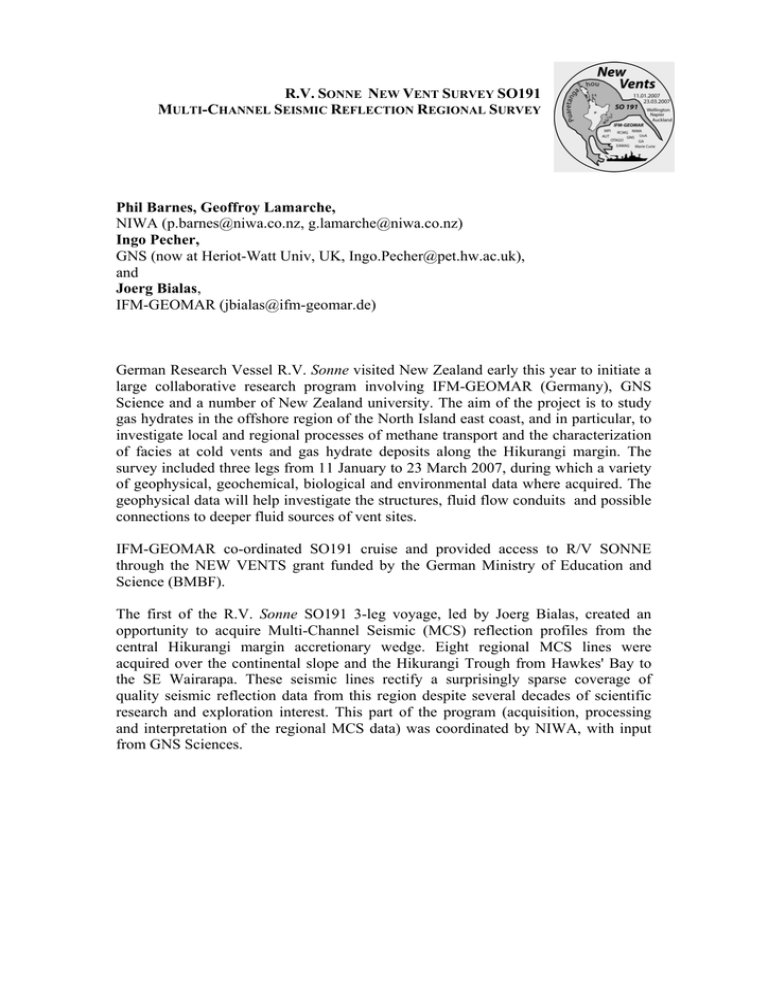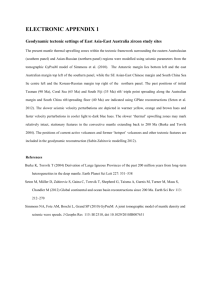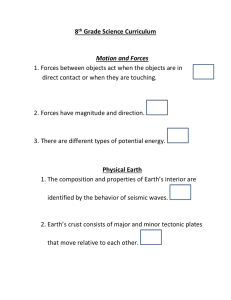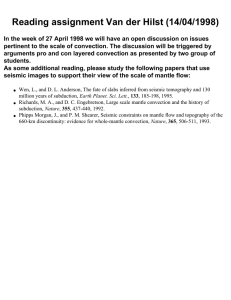RV SONNE NEW VENT SURVEY SO191 Phil Barnes
advertisement

R.V. SONNE NEW VENT SURVEY SO191 MULTI-CHANNEL SEISMIC REFLECTION REGIONAL SURVEY Phil Barnes, Geoffroy Lamarche, NIWA (p.barnes@niwa.co.nz, g.lamarche@niwa.co.nz) Ingo Pecher, GNS (now at Heriot-Watt Univ, UK, Ingo.Pecher@pet.hw.ac.uk), and Joerg Bialas, IFM-GEOMAR (jbialas@ifm-geomar.de) German Research Vessel R.V. Sonne visited New Zealand early this year to initiate a large collaborative research program involving IFM-GEOMAR (Germany), GNS Science and a number of New Zealand university. The aim of the project is to study gas hydrates in the offshore region of the North Island east coast, and in particular, to investigate local and regional processes of methane transport and the characterization of facies at cold vents and gas hydrate deposits along the Hikurangi margin. The survey included three legs from 11 January to 23 March 2007, during which a variety of geophysical, geochemical, biological and environmental data where acquired. The geophysical data will help investigate the structures, fluid flow conduits and possible connections to deeper fluid sources of vent sites. IFM-GEOMAR co-ordinated SO191 cruise and provided access to R/V SONNE through the NEW VENTS grant funded by the German Ministry of Education and Science (BMBF). The first of the R.V. Sonne SO191 3-leg voyage, led by Joerg Bialas, created an opportunity to acquire Multi-Channel Seismic (MCS) reflection profiles from the central Hikurangi margin accretionary wedge. Eight regional MCS lines were acquired over the continental slope and the Hikurangi Trough from Hawkes' Bay to the SE Wairarapa. These seismic lines rectify a surprisingly sparse coverage of quality seismic reflection data from this region despite several decades of scientific research and exploration interest. This part of the program (acquisition, processing and interpretation of the regional MCS data) was coordinated by NIWA, with input from GNS Sciences. Figure 1 Regional tectonic structures. Major faults (black) and anticlinal ridges (red) interpreted from bathymetric and seismic reflection data in the central Hikurangi margin. Lines indicate the location of the Sonne SO191 Leg 1 profiles. MCS data were acquired using NIWA's new digital GeoEel streamer and acquisition system from Geometrics Inc. The 400 m-long streamer consisted of 32 groups at 12.5 m interval. A gun array of 4x520 in3 was used for lines 1 to 6 and a GI gun in 250/105 in3 for lines 8 to 10. All lines were processed onboard to post-stack time migrated sections, and preliminary interpretations were completed. Two of the regional lines (SO191 –1 and 3) extend across the entire margin from the shelf to the Hikurangi Trough, and tie into the 2005 NZ MED Crown Minerals data. SO191–4 extends line GNS/MED–38 across the subduction deformation front, and was recorded with both towed streamer and with six OBS deployed along the line 5 NM apart. Line SO191-6 extends across the lower slope and trench. Line SO191 –9 was recorded across the Wairarapa seep site off Cape Palliser in the south of the margin. The aims of the study were: (1) Identification of the primary subduction décollement, upper plate and subducted sequence. (2) Evaluation of along-margin variations in regional tectonic structures and subduction processes, including the effects of subducting seamounts. (3) Establishing characteristics of the trench-fill sedimentary sequence entering the subduction system. (4) Determining amounts and rates of tectonic shortening, so that kinematic models of plate boundary deformation can be improved. (5) Evaluation of mechanisms of tectonic accretion and thrust fault evolution. SO191 regional seismic reflection lines are of good quality, despite the short streamer, and typically image 3.0-3.5s two-way travel (TWT) beneath the seafloor. The trenchfill turbidite section, together with the pelagic sediments and oceanic crust of the Hikurangi Plateau are well imaged in the Hikurangi Trough, where up to 4.0s TWT of seismic penetration was achieved. The main subduction interplate thrust can be identified as a major décollement between the subducted sequence and the accretionary wedge. This décollement can be interpreted along the seismic sections to about 35-40 km down the dip of the subduction zone, where it becomes masked by the primary seafloor multiple at about 6.5s TWT. Figure 2 Example of seismic section (SO191-6) across the deformation front of the Hikurangi subduction zone. All profiles were processed onboard to post-stack time migrated sections, and were interpreted. The structures in the upper plate thrust wedge are impressive, with many forward- and back-verging thrusts clearly imaged in the profiles. In the mid-slope region, there appears to be a significant tectonic buttress, with the upper margin sequences differing in their reflective characteristics from what are clearly accreted trench fill turbidites beneath the lower slope. Major thrusts faults typically coincide with bathymetric ridges, and can be traced along strike from multibeam bathymetric data. Slope basins between the ridges are variously infilled with sediments up to about 1.52.0 s TWT thick. Across the principal deformation front there is a spectacular zone of “protothrust” deformation. These faults represent a zone of incipient deformation up to 25 km wide that has developed in advance of the main deformation front (Figure). The structures were recognized in previous surveys, but not with such clarity. The new data also reveal an interesting change in the vergence of the protothrusts along the strike of the margin. Lines SO191–3 and –4 cross a 70 km long seamount ridge that is entering the subduction zone in the centre of the margin. By comparing the structure and stratigraphy on these two lines with that on lines SO191–1 and –6, to the north and south respectively, we can identify the early deformation effects of subducting seamounts on accretionary wedges. The gas hydrate zone in the first few hundred meters beneath the seafloor is ideally imaged with higher-frequency sources than the large G gun array used for the regional MCS. However, the sharp waveform of the gun array still made it possible to image the shallow sub-seafloor in surprising detail. The only significant difference to the processing used for the regional images was binning at 6.25 rather than 12.5 m. Numerous small-offset faults are resolved nicely. The image also displays two features that are typical for BSRs on the Hikurangi margin. The BSR is broken up, often with sharp lateral terminations. It often occurs in sediment packages with reduced reflectivity, which is likely to be caused by a destruction of the sediment frame by intense fracturing during deformation – although in this specific case, the decrease of reflection amplitudes at least beneath the eastern flank of the anticline may also be caused by the steep dips of the layer package. A comparison of BSR occurrences with stratigraphic and structural interpretations of the regional lines will prove invaluable for studying the sources and migration paths of gas for hydrate formation on the Hikurangi margin. The data as a whole, combined with existing data, will enable improved imaging of a fundamental tectonic transition from accretion in the central Hikurangi Margin to subducting seamounts and tectonic erosion in the north. We also expect to be able to analyse geological strain rates through balancing of the depth converted seismic sections.





